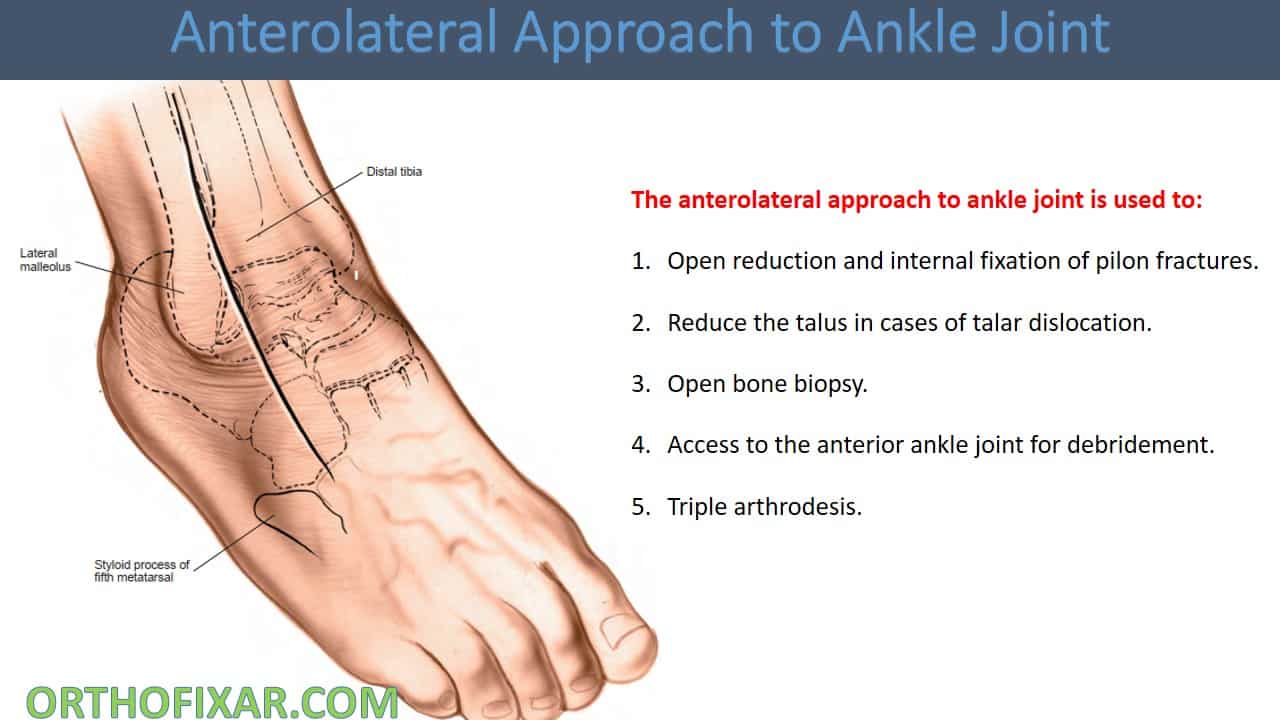Anterolateral Approach to Ankle Joint

Anterolateral Approach to Ankle Joint indications:
The full extent of the anterolateral approach to the ankle and hindpart of the foot allows exposure not only of the ankle joint, but also of the talonavicular, calcaneocuboid, and talocalcaneal joints.
The anterolateral approach to ankle joint is used to:
- Open reduction and internal fixation of pilon fractures.
- Reduce the talus in cases of talar dislocation.
- Open bone biopsy.
- Access to the anterior ankle joint for debridement.
- Triple arthrodesis.
See Also: Ankle Anatomy
Position of the Patient
Place the patient supine on the operating table; place a large sandbag underneath the affected buttock to rotate the leg internally and bring the lateral malleolus forward.
Landmarks and Incision
Landmarks:
- Lateral malleolus.
- Base of the fifth metatarsal
Incision:
- Make a 15-cm slightly curved incision on the anterolateral aspect of the ankle.
- Begin some 5 cm proximal to the ankle joint, 2 cm anterior to the anterior border of the fibula.
- Curve the incision down, crossing the ankle joint 2 cm medial to the tip of the lateral malleolus, and continue onto the foot, ending some 2 cm medial to the fifth metatarsal base, over the base of the fourth metatarsal.

Internervous plane
The internervous plane for the anterolateral approach to ankle joint lies between:
- The peroneal muscles which are supplied by the superficial peroneal nerve.
- The extensor muscles which are supplied by the deep peroneal nerve.
Superficial dissection
- Incise the fascia in line with the skin incision, cutting through the superior and inferior extensor retinacula.
- Do not develop skin flaps. Take care to identify and preserve any dorsal cutaneous branches of the superficial peroneal nerve that may cross the field of dissection.
- Identify the peroneus tertius and extensor digitorum longus muscles, and, in the upper half of the wound, incise down to bone just lateral to these muscles.
Deep dissection
- Retract the extensor musculature medially to expose the anterior aspect of the distal tibia and the anterior ankle joint capsule.
- Distally, identify the extensor digitorum brevis muscle at its origin from the calcaneus and detach it by sharp dissection.
- During dissection, branches of the lateral tarsal artery will be cut; cauterize (diathermy) these to prevent the formation of a postoperative hematoma.
- Reflect the detached extensor digitorum brevis muscle distally and medially, lifting the muscle fascia and the subcutaneous fat and skin as one flap.
- Identify the dorsal capsules of the calcaneocuboid and talonavicular joints, which lie next to each other across the foot, forming the clinical midtarsal joint.
- Next, identify the fat in the sinus tarsi and clear it away to expose the talocalcaneal joint, either by mobilizing the fat pad and turning it downward or by excising it.
- Preserving the fat pad prevents the development of a cosmetically ugly dimple postoperatively. Preserving the pad also helps the wound to heal.
- Finally, incise any or all the capsules that have been exposed. To open the joints, forcefully flex and invert the foot in a plantar direction.




Approach Extension
Proximal extension:
The Anterolateral Approach to Ankle Joint can be extended proximally to explore structures in the anterior compartment of the leg.
Continue the incision over the compartment, and incise the thick deep fascia in line with the skin incision.
Distal extension:
The Anterolateral Approach to Ankle Jointalso can be extended distally to expose the tarsometatarsal joint on the lateral half of the foot.
Continue the incision over the fourth metatarsal, and expose the subcutaneous tarsometatarsal joints.
Dangers
The structures at risk during anterolateral approach to ankle joint include:
- Superficial peroneal nerve.
- Deep peroneal nerve.
- Anterior tibial artery.
References
- Surgical Exposures in Orthopaedics book – 4th Edition
- Campbel’s Operative Orthopaedics book 12th
- Youtube
April 17, 2022
OrthoFixar
Orthofixar does not endorse any treatments, procedures, products, or physicians referenced herein. This information is provided as an educational service and is not intended to serve as medical advice.
- Lifetime product updates
- Install on one device
- Lifetime product support
- Lifetime product updates
- Install on one device
- Lifetime product support
- Lifetime product updates
- Install on one device
- Lifetime product support
- Lifetime product updates
- Install on one device
- Lifetime product support